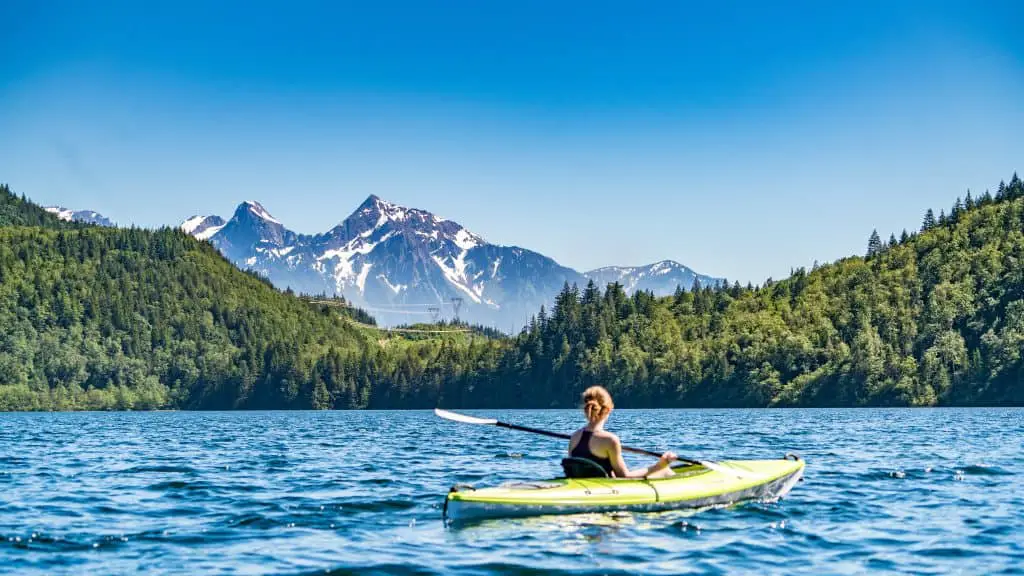Living the van life gives you the freedom to explore wherever the road takes you. Add a kayak to the mix, and you’ve got a whole new watery world to explore, too.
But, as every van lifer knows, space is a luxury, and hauling a kayak around isn’t always that easy.
That’s why I’ve rounded up a few of my favourite types of kayaks for you to consider. Along with some smart ideas that can help you to integrate them into living the van life.

Disclaimer: Some links in this article are affiliate links, which means that if you purchase through them I receive a small commission, at no extra cost to you. This helps cover the cost of running this blog. Thanks for your support!
On-the-Road and On-the-Water: Kayak Options for Van Lifers
1. Folding Kayaks
My top pick for campervan kayaks has to be foldable kayaks, as they usually offer the best performance of all the collapsible kayak designs.
A flexible waterproof skin covering a rigid frame is usually used, but there are some more contemporary designs that use folding panels. These create the kayak’s hull when they snap together. Either of these options creates a hull that’s stiffer than inflatable kayaks. In some cases, they approach the level of performance of hard-shell touring designs.
Folding kayaks are compact enough for easy storage and travel. You can tuck them away inside your van in very small spaces and simply unfold them when you want to get on the water.
They are usually more expensive than inflatable kayaks, but they offer better handling and stability. Folding kayaks are also pretty light—far more lightweight than standard polyethylene kayaks—so they’re very easy to carry from your van to the water as well.
3. Fishing Kayaks
Are you committed to living off the land as you pursue the van life? Then fishing kayaks are a great way to help you catch your dinner! They’re the perfect choice when you’re driving in areas where shops are few and far between and you have to put something on your plate for dinner.
Fishing kayaks feature specialized designs aimed at recreational paddlers, and most of them are sit-on-top. This means they allow for a good range of movement, they make landing fish easier, and they offer more safety when you’re far from shore.
- 18-gauge PVC construction is rugged for lake use
- 1000D tarpaulin bottom and 840D nylon cover provide durable protection from punctures
- Multiple air chambers allow another chamber to stay inflated if one is punctured
- International products have separate terms, are sold from abroad and may differ from local products, including fit, age ratings, and language of product, labeling or instructions.
You’ll be able to stand in some fishing kayaks as many of them are slower than their narrower counterparts but have a wider beam for stability. Another benefit of wider designs is that you can mount the seats higher, so you can see and cast better.
Check out Nick using our kayak to go fishing during a campervan trip to Turkey in the video below.
3. Recreational Kayaks
Recreational kayaks are all about value, fun, and stability. Whether you sit inside or on top, you’re looking at premium stability. While they aren’t as quick as touring kayaks, they’re far more steady, so they’ll give you an easier time out on the water.
Recreational kayaks often have very basic features, so they are affordable. In some cases, you’re looking at a straightforward kayak hull with somewhere to sit and very little else. More upmarket designs incorporate some of the features that touring kayaks have. These include bulkheads and hatches for dry storage. You can also use deck elastics to stash a water bottle onboard, sunscreen, or anything else you need to get your hands on quickly.
Recreational kayaks come in a wide variety of designs and lengths. This is something van lifers will have to take into careful consideration as they choose according to the amount of space they have available. You can choose to mount it on your roof or store it inside your van, whichever is more convenient.
4. Inflatable Kayaks
Now for the most practical option for van life—an inflatable kayak. If you’re a van lifer who just wants to enjoy some gentle paddling, a kayak that can fit in your closet or behind a sofa should be your first choice. Even the equipment for inflating them doesn’t take up much room!
You’ll need either a hand pump or an electric air pump, and neither of them requires much storage space, so your kayak and pump can be stowed away easily.
Recreational inflatable kayaks are more suited to quiet water adventures, but you do get higher-end fishing kayaks and white water inflatables, too. Both are available in solo and tandem designs. However, they’re less rigid than hard-shell designs, so they’re not capable of quite the same level of performance. They’re also less durable than standard kayaks, so they may not last as long. The good news is that most recreational inflatable kayaks are cheaper than other models, so they’re easy on your bank account.
Kayak Guru has a great list of inflatable kayak pros and cons, so you can learn more about what they offer and why they differ. However, they get my vote as they’re so easy to store, especially if you’re on your own.
- Challenger K1 One Person Kayak set is made from Intex “Super-Tough” vinyl which is a high molecular PVC that is unaffected by gasoline, oil and salt water.
- It is highly resistant to damage from abrasion, impact and sunlight. It also permits more air pressure for rigidity, making it perfect for river and sea action.
- The K1 comes with 84″ aluminum oars and a high-output hand pump. The hard plastic skegs on the underside of the kayak (similar to the underside of a surfboard) provide directional control so you can…
- The kayaks feature inflatable seats with backrests, inflatable I-beam floors, grab lines on both ends, and a cargo net for extra storage. The sets also includes a repair patch.
- Usage en eau douce ou sur un lac
- Design profilé pour faciliter le paysage
- Assise et dossier gonflable amovibles et ajustables
- Vinyle renforcé très résistant : Qualité INTEX certifiée
- Inflated size 351cm x 76cm x 38cm)
- Includes a high-output pump and 84″ aluminium oars
- Capacity 2 persons maximum weight 160kgs (350lbs)
- TUV approved ISO 6185-1 “Inflatable Boats”
Read Next:
- The best Dutch Ovens for camping
- 21 must have campervan accessories
- A complete day hiking packing list
Traveling With Your Kayak
As a van lifer, you need to travel with everything you need, including your kayak! If your kayak isn’t inflatable or foldable, you’ll likely need to tie it to your roof.
The main goal when you’re securing your kayak is to ensure it doesn’t dislodge from your van as you’re cruising down the highway. Tie-downs are usually used to prevent this, and these can be ropes or straps.
If you’re using ropes, they should secure your kayak on both ends of your van. If you’re using straps, find ones with plastic or rubber ends that cover the metal buckle. This reduces the risk of your van getting damaged when the strap gets thrown over the vehicle or when a strong wind blows the strap around.
I recommend ratcheting straps because over-tightening can damage your kayak and your van. Bungee cords don’t offer enough security or support, so you shouldn’t use them.
What you want to do is secure the tie-down to the main base and ensure the kayak sits firmly beneath the tie-downs. For added security, attach the bow and stern lines from the kayak to your vehicle. This helps with the kayak’s side-to-side movement when it’s on your roof. It’s also helpful when you’re traveling on the highway or on a windy day.


Storing Your Kayak
The best tip I have for kayak storage is that you should keep it out of direct sunlight and avoid the elements. UV rays cause a lot of damage, and kayaks can become brittle and weathered if they’re left in the sun. Tarps are your friend in preventing damage, especially if you’re strapping your kayak to your roof for long periods.
Then there’s damage from water microorganisms, pollution, and salt corrosion. This is more easily prevented: simply rinse off your gear in fresh water each time you use it. Do a deeper clean three or four times a year using a mild soap. Anything stronger can cause damage.
Tip for Extending the Life of Your Kayak
Here are a few things to think about for getting the most out of your kayak:
- Add UV Protection
If you’ve got a hard-shell kayak, applying a sun-protective spray will provide protection from harmful UV light.
- Distribute Weight Evenly
A kayak’s hull can bend and deform over time if the weight distribution is uneven. When you store your kayak, make sure the weight of it is supported at points along its length. It’s a good idea to use padded cradles or wide nylon straps so you can match the curve of the hull. Supporting the kayak at about one-third of the way in on each end is the most effective approach.
- Keep It Clean
When cleaning your kayak, avoid strong chemicals and solvents that could damage it. Let it air out and dry properly before you stow it away.
- Remember Your Accessories
Don’t forget the extras. These include the bilge pump, paddles, and spray skirt float bags. My advice is to remove them from your kayak, rinse them with clean, fresh water, allow them to dry, and then stow them inside your van if you’ve got the space.

Loading a Kayak by Yourself
Some people have the height and strength to lift their kayaks onto their vans by themselves. But if that’s not you, check out these tips for solo loading:
- Get Rolling Wheels
There are rack solutions that incorporate rolling wheels. They allow you to simply put the bow of the kayak in the cradle for the rear rack, pick up the kayak by the stern end, and roll the kayak forward into its cradle at the front.
- Use a Lift System
Kayak racks with integrated lift systems that simplify loading the kayak are readily available. They usually slide from the top of your van down one side, so you won’t have to lift your kayak as high. Once your kayak has been properly loaded and securely strapped down, you need to lift the rack system up on top of your vans.
- Use Blankets, Towels, or Pool Noodles
Now for the low-cost, low-tech solution! Try putting a blanket, towel, or pool noodles on top of the rear of your van and then putting the kayak’s bow on this. Pick up the stern and push the kayak up and forward until it’s in place.
Final Thoughts on the Best Kayaks for Van Life
Kayaks give you the freedom to explore the sea, lagoons, lakes, and rivers in new and exciting ways. They’re an excellent addition for any campervan setup as they give you even more freedom, and paddling is great exercise too!
There are as many ways to use kayaks as there are different types of kayaks. Knowing which one will work for you as you live your best van life is key. Hopefully, this guide helped you find what you’re looking for.
Guest Post by Nick Kelly







